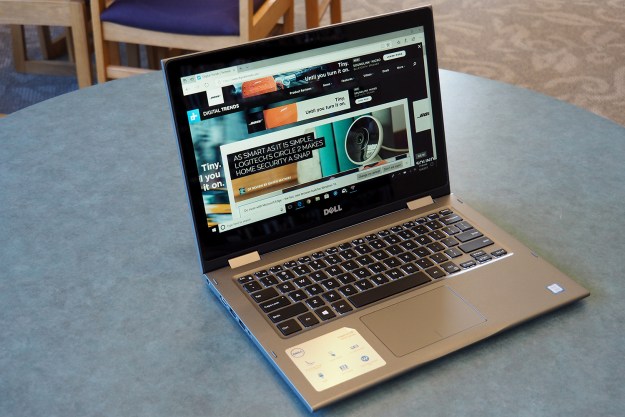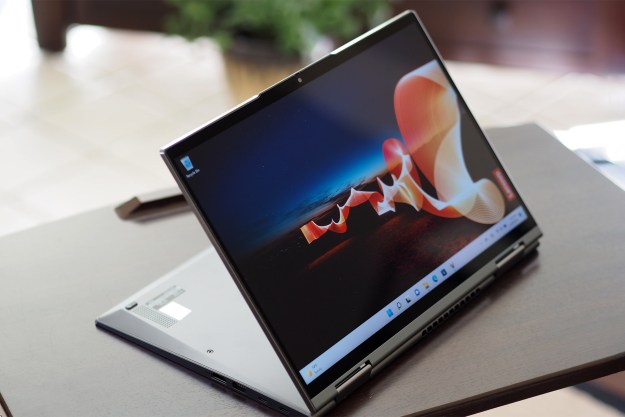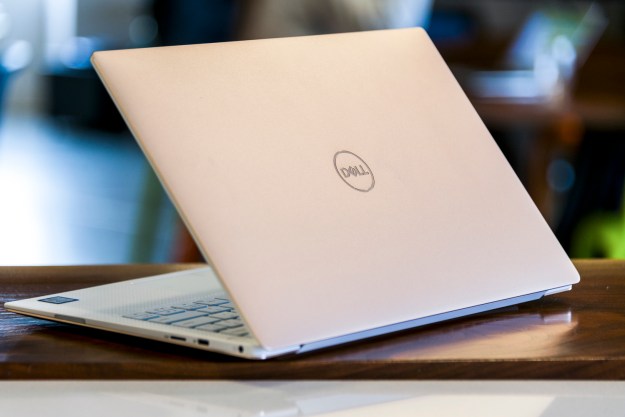
“The Dell Inspiron 13 5000 2-in-1 performs for its budget price, but it doesn’t last.”
- Solid performance
- Wide range of budget prices
- Reasonable build quality
- Poor battery life
- Scratchy touchpad surface
- Keyboard is merely adequate
- Relatively thick and heavy
- Slower storage speeds
Dell’s Inspiron line is a classic example of significant growth in the ultra-flexible 2-in-1 market, with the 5000 and 7000 lines offering a one-two punch for budget users.
Dell sent us a review unit that’s been updated with the excellent quad-core eighth-generation Intel Core i5-8250U processor, 8GB of DDR4-2400MHz RAM (a slight uptick in speed), a 256GB SATA solid-state drive (SSD), and a 13.3-inch Full HD (1,920 x 1,080 or 166 PPI) display for the reasonable price of $750. That compares to the Inspiron 13 7000 2-in-1 that comes in at $850 for the same configuration. Note that you can up the CPU to a Core i7-8550U, 16GB of
We’ll get to the differences between the Inspiron 13 2-in-1 models throughout this review, to answer two questions: Is it worth saving a little bit of money to drop down to a lesser model, and does the updated Inspiron 13 5000 2-in-1 manage to balance low price with good performance?
A decent enough — albeit plastic — design and build
We gave the Inspiron 13 7000 2-in-1 high marks for its solid metallic design, and that’s one area where the Inspiron 13 5000 2-in-1 compromises. Rather than using an aluminum chassis, the Inspiron 13 5000 opts for an all-plastic design. That’s unchanged from the older model. It’s also heavier, at around 3.7 pounds versus the Inspiron 13 7000’s 3.2 pounds, and thicker at 0.80 inches (at its thickest point) compared to 0.60 inches.
Being made of plastic doesn’t mean it feels downright cheap, however. The Inspiron 13 5000 2-in-1 has a decent build quality and a chassis that we found mostly free from bending and twisting. In our testing, the lid did give a bit under moderate pressure and the keyboard deck was just slightly mushy, which tended to mark it as a budget machine. The Inspiron 13 7000 steps up the build quality for only a moderate upcharge.
The Inspiron 13 5000 2-in-1 provides solid productivity performance, for any price.
That said, Acer’s less expensive Swift 3 ($650) clamshell notebook proves that you don’t have charge a pretty penny for a metal chassis with a more solid feel to it, as does the similarly price Asus ZenBook UX330UA. Then again, those machines lack the Inspiron 13 5000’s more flexible 2-in-1 form factor. To jump up yet another level of build quality in 2-in-1s means choosing something like the Asus ZenBook Flip 14 that retails for $900 or the Microsoft Surface Pro that starts at $800 (without its detachable keyboard).
One area where the Inspiron 13 5000’s budget nature really shows up is the hinge. We found it quite stiff, requiring both hands to open the lid, and the display was nevertheless quite wobbly when we used it in the lap. It managed to hold things together when we flipped the display around to the three 2-in-1 modes, but the thickness and weight made it particularly uncomfortable as a tablet. A thinner (0.55 inches) and lighter (3.3 pounds) machine like the Asus ZenBok Flip 14 makes for a more pleasant tablet experience.
Aesthetically, the Inspiron 13 5000 2-in-1 is non-descript, and its bezels, while not huge by the standards of a few years ago, still haven’t been shaved down to match today’s most modern notebooks – including the Inspiron 13 7000. The light grey plastic chassis won’t win any beauty contests, but it won’t embarrass when it’s pulled out at the conference room table either.
Bountiful old-school connectivity
As usual for thicker notebooks, the Inspiron 13 5000 2-in-1 enjoys a decent collection of ports. Two USB-A 3.1 connections line the left-hand side, along with a full-size HDMI port, a 3.5mm audio jack, and the proprietary charger input. On the right-hand side, a single USB-A 2.0 port sits in between an SD card reader and a Noble lock security slot. In a nod to the machine’s budget nature, there’s no USB-C port, although the ZenBook UX330UA and the Swift 3 both manage to squeeze one in.
Wireless connectivity comes by way of dual band 802.11ac Wi-Fi and Bluetooth 4.2. Dell bundles its SmartByte software that prioritizes media streaming for a more consistent video experience.
Mostly adequate input, but the touchpad is a bit scratchy
The Inspiron 13 5000’s island keyboard is set in a shallow depression in the chassis and exhibits only slight flexing under pressure. The keys are black with legible white lettering and the backlight has two brightness levels, although they’re so similar that it’s difficult to tell them apart. The lights are consistent, though, and suffer from only minimal light bleed, and so the keyboard is quite pleasant to use in a dark environment.
The keys were a bit shallow at 1.1mm, and although the overall feel was firm the action slightly bottomed out at the end. It’s a perfectly serviceable keyboard that closely mimics the feel on the Inspiron 13 7000 2-in-1 and isn’t nearly as precise as keyboards on more premium systems like the HP Spectre x360 13.
The touchpad isn’t quite so positive an experience. Although it conforms to the Microsoft Precision touchpad protocol, and therefore provided reliable Windows 10 gesture support, we found its plastic surface to be rather rough. It does provide sufficient feedback while swiping, but it results in slightly unpleasant gritty experience.
The Inspiron 13 has the usual 2-in-1 multitouch display that was responsive and accurate. You can also purchase Dell’s active pen for Windows 10 Ink support, but one was not included with our review unit and so we were unable to test it. You can pick one up for $35 at the Dell online store.
In a real plus for a budget machine, the Inspiron 13 5000 leverages infrared cameras installed on top and next next to the webcam for Windows 10 Hello support via facial recognition. We found the system to be fast and reliable.
The display represents a clear cost-cutting measure
The Inspiron 13 5000 2-in-1 is equipped with a Full HD IPS display, which tends to promise wide viewing angles and a generally pleasant experience. We were pleased with the screen on the slightly more expensive Inspiron 13 7000, which left us hopeful that this wasn’t the place where Dell tried to shave some cost.
As it turns out, the Inspiron 13 5000’s display is a bit disappointing but not entirely unexpected for a budget machine. Contrast was fine at 870:1 at full brightness, which is in line with our comparison group and bettered only by the ZenBook UX330UA and Dell XPS 13 (which starts at $800). And, color accuracy is also roughly average at 2.3 (less than 1.0 is considered excellent).
Things go down from there, however. To begin with, maximum brightness is poor at 198 nits. That’s not enough to overcome any kind of brighter environment. Gamma was 2.4, which means videos and images are likely to be darker than they should be. And, the display’s color support is extremely narrow with only 47 percent coverage of the AdobeRGB gamut. The reasonably priced Asus ZenBook UX330UA stands out here as offering a good display at a budget price.
Our real-world experience with the display was in line with our colorimeter’s results. The display was just okay for productivity use, with passable black text on white backgrounds and a serviceable browsing experience. But video was dark, images lacked pop, and the display just couldn’t compete with bright lights. It’s not a terrible display by any means, but it’s definitely one are where Dell clearly cut some costs to bring the Inspiron 13 5000 into the budget field.
Solid sound for solitary users
Dell equipped the Inspiron 13 5000 with Waves MaxxAudio Pro audio that promises an enhanced soundstage for music and video. In our experience, the machine put out sound that was surprisingly detailed, with good stereo separation that enhanced the movie watching experience. Music was fairly typical for notebooks, with decent highs and midrange but weak bass. Volume was relatively low, though, making it best for individual use.
Impressive performance for a budget 2-in-1
The Inspiron 13 5000 2-in-1 picked up the latest quad-core eighth-generation Intel Core processors, in the case of our review unit the Core i5-8250U. The newest CPUs are great performers with some real efficiency built in, and so we had high expectations for the Dell’s performance numbers.
We weren’t disappointed. The Inspiron 13 5000 scored a solid 4079 in the Geekbench 4 single-core test and 12824 in the multi-core test. That’s slightly behind the Inspiron 13 7000 and the Asus ZenBook UX330UA, both using the same Core i5-8250U, and it beats out our comparison machines still equipped with dual-core seventh-generation Intel Core processors. The Swift 3, for example managed only 3809 and 7515.
In our more demanding Handbrake video encoding test, which taxes the processor for a longer period to shake out any thermal-related issues, the Inspiron 13 5000 did very well at 709 seconds. That’s again a bit behind the Inspiron 13 7000, but faster than the ZenBook UX330UA. It’s twice as fast as the Swift 3 and Yoga 720 13, showing off the significantly improved performance of the latest generation of Intel Core CPUs.
Our real-world testing confirmed these benchmark results, with the Inspiron 13 5000 2-in-1 providing solid productivity performance. Web browsing, media consumption, and working in Office 2016 was fast and efficient, and the quad-core CPU means you can get some higher-level creative work done in a pinch. The fans did run when the processor was being pushed, but the Inspiron 13 5000 was otherwise relatively quiet.
Slow storage, even for a SATA drive
You can buy the Inspiron 13 5000 2-in-1 with anything ranging from a 1TB SSD up to a 512GB SSD, and we were glad to see Dell equip our reasonably-priced review unit with a 256GB SSD for some added performance. It’s a SATA version, however, meaning that we weren’t expecting the same kind of performance as pricier machines that sport PCIe SSDs.
Unsurprisingly, the Inspiron 13 5000’s CrystalDiskMark results were unspectacular, at 492 megabytes per second (MB/s) in the read test and 391 MB/s in the write test. The Inspiron 13 7000’s SATA SSD was slightly faster at 537 MB/s and 500 MB/s, respectively, while the Acer Swift 3’s surprising PCIe SSD put that budget machine into another class of performance at 1169 MB/s and 512 MB/s.
As usual, while this is a slow SSD, it doesn’t actually result in a slow notebook. Booting the Inspiron 13 5000 was quick enough, and we didn’t notice any slowdowns during our real-world testing. If you need to work with very large files then you might notice that things are slower than you’d like, but for most productivity tasks these speeds should be sufficient.
The usual integrated graphics gaming limitations
You don’t expect machines of any price equipped with the Intel UHD 620 integrated graphics to be good for much more than casual gaming. We therefore suspected that the Inspiron 13 5000 2-in-1 would join the club of systems that just don’t have the firepower for modern titles.
As we suspected, the machine scored right in line with other similar systems in the 3DMark synthetic benchmark, specifically scoring 840 in the Fire Strike test. That’s a bit on the low side of our comparison group, but frankly not enough so to make a practical difference in any of today’s modern gaming titles.
The SATA SSD that Dell chose for the Inspiron 13 5000 is one of the slowest we’ve tested.
Nevertheless, we still ran the Inspiron 13 5000 2-in-1 through the Civilization IV benchmark at Full HD, and tested it at medium and ultra graphics detail. The results: 10 frames per second (FPS) and 5 FPS, respectively. Again, that’s no better or worse than our comparison group and it means you’ll want to stick to older games or Windows 10 casual games and leave your hardcore gaming to another machine. If you want slightly better performance in a 2-in-1 without spending a lot more, then the ZenBook Flip 14 with its discrete Nvidia GeForce MX150 GPU is a good option.
A chunky chassis and poor battery life seriously limits portability
Likely thanks to the Inspiron 13 5000 2-in-1’s thicker frame, Dell managed to pack in a 42 watt-hour battery. That’s larger than the Inspiron 13 7000’s 38 watt-hour battery, which with the same Core i5-8250U suffered from some poor battery life. Given the larger capacity, we expected the Core 13 5000 to provide at least a little more longevity.
Things didn’t start out well. In our most aggressive Basemark web benchmark that pushes the CPU and GPU, the Inspiron 13 5000 2-in-1 couldn’t quite make it to a full two hours. It finished only a few minutes longer than its slightly more expensive sibling. The ZenBook UX330UA lasted for a much more solid four hours and 15 minutes.
On our web browsing test that runs through a series of popular sites until the battery runs out, the Inspiron 13 5000 redeemed itself the slightest bit, lasting four hours and 50 minutes compared to the Inspiron 13 7000’s four hours and 17 seconds. That’s more in line with what we expected given the larger battery. However, it’s still way behind the ZenBook UX330UA’s eight and a half hours, and the Yoga 720 13 lasted for more than six and a half hours.
The Inspiron 13 5000 2-in-1 won’t last even close to a full work or school day away from a charge.
Then, things really fell apart in our video test, which loops through an Avengers video. The Inspiron 13 5000 couldn’t even make it to six hours, which is a very poor result and far less than the Inspiron 13 7000’s seven hours and 42 minutes. We even repeated the test to see if these results were consistent, and they were. The ZenBook UX330UA lasted for over 11 hours, the Acer Swift 3 lasted for more than 10, and the Yoga 720 13 almost made it to ten hours of longevity.
The bottom line is that the Inspiron 13 5000 2-in-1 isn’t going to last a full work or school day away from a charger. In fact, you’ll need to plug it in by lunchtime, even if you’re not stressing the processor. That’s not good, even by budget standards today.
Beyond just its poor battery life, the Inspiron 13 5000 2-in-1 is also a bit chunky at just over 3.7 pounds and between 0.77 and 0.80 inches thick. It still fits into a backpack thanks to its overall dimensions, but you’re going to be well aware that it’s there. Having to carry around its proprietary power brick to keep working is just adding insult to injury.
Software
Dell packs in a few extra pieces of software to go with the usual Windows 10 load of casual games and Microsoft utilities. There’s a McAfee antivirus trial, Adobe PDF app, and Dropbox software to take advantage of the free 20GB of space included for a year. Otherwise, the usual Dell diagnostic and support apps are on hand.
Warranty information
The Inspiron 13 5000 2-in-1 comes with a standard 1-year mail-in parts and service warranty. That’s par for the course, even for more premium notebooks.
Our Take
Dell improved the Inspiron 13 5000 2-in-1 with the newest quad-core eighth-generation Intel Core processor, and performance is certainly better. It retains its plastic build that’s mostly decent but a bit too bendy in places, and it offers usable input options. However, its battery life is just disappointing, and it’s a bit too thick and heavy to make it comfortably portable for its size.
Is there a better alternative?
In terms of 2-in-1s, the Inspiron 13 5000’s strongest competition is from Dell itself in the Inspiron 13 7000. It’s only $100 more for the same core i5-8250U CPU, 8GB of
On the other hand, if you’re determined to stick with a 2-in-1 but can give up Windows 10, then the Samsung Chromebook Pro is an intriguing option. It’s less expensive at $550 for a seventh-generation Intel Core m3 processor, 4GB of
Finally, you can step outside of the 2-in-1 space and pick up the Asus ZenBook UX330UA clamshell notebook. You’ll get a superior build, equally good performance with the latest eighth-generation CPU refresh, and much better battery life. And, you’ll pay a very similar $750 for a Core i5-8250U, 8GB of
How long will it last?
The Inspiron 13 5000 2-in-1 isn’t quite in the premium category in terms of build quality, but it still feels like it should last as long as you need it to assuming that it’s taken care of. The eighth-generation Intel Core CPU is up to date, but the SSD is slow. The lack of USB-C means that connectivity will get dated as that standard continues to take over.
Should you buy it?
No. The Inspiron 13 5000 2-in-1’s battery life is just too poor. There are other budget machines available at similar prices that will last longer on a charge, and the Inspiron 13 5000 is just too heavy by itself to make carrying the charger around a reasonable proposition.
Editors' Recommendations
- Dell XPS vs. Dell Latitude: here’s how to decide
- 9 best laptops of 2024: tested and reviewed
- The best 2-in-1 gaming laptops for 2024
- Which is better: Dell Latitude or Inspiron?
- Why the Dell XPS 13 Plus still beats the latest competition in little laptops








